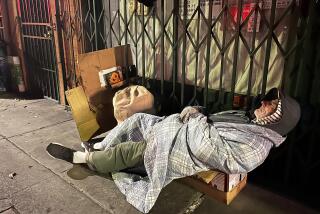Anti-Gridlock Law Makes Illegal What Used to Be Just Impolite
You’ve been stopped at the same light for three cycles now, creeping toward that choked intersection at a glacial pace.
But at last, your chance seems to have come. The car in front of you has made it almost to the other side, and you’re close behind--a little too close, maybe. You can’t go any farther because of the stalled traffic in front of you, but at least your front wheels are in the intersection by the time the light changes.
So what if those cars on the equally crowded cross street have no room to move when they get the green light? You’re in a hurry. And besides, you had the green when you pulled forward, so all those other drivers might as well stop glaring at you. After all, you haven’t broken any laws, right?
Wrong! Aside from being rude and inconsiderate, you’re in violation of Section 22526, Chapter 739 of the California Vehicle Code, also known as the Anti-Gridlock Act of 1987.
Don’t be surprised if you don’t remember that one from the driving test you took years ago. It only went into effect in January of this year. Before that, such behavior may not have been nice, but it was perfectly legal, says Ken Daily of the California Highway Patrol’s San Juan Capistrano office.
So far, the new law’s impact has been less than dramatic, largely because so few drivers are aware of it. Even if they have heard of it, “a lot of them don’t really know what it means,” Daily says.
It might also be that with all the talk about gridlock these days, some of us may have forgotten what the word really means. “Gridlock is when traffic does not clear before the light turns green for the opposing traffic,” says Tom Fortune, a spokesman for the Orange County Transportation Commission. “But lately it’s been broadened to mean any heavy traffic.”
But when one Orange County driver found out about the law, he understood exactly what it meant. And he decided to spread the word.
“I come to work up Main Street in Santa Ana, and I usually turn on Broadway. And about 70% of the time, that intersection is blocked,” says Thomas F. Riley, a frustrated driver who also happens to be a county supervisor and chairman of the Transportation Commission. “That really irritates me.”
It happens so often, in fact, that Riley’s staff has come to know exactly what he means when he arrives at the office and fumes: “Somebody did it again!”
Stanley T. Oftelie, executive director of the Transportation Commission, says Riley is far from alone in his frustrations. “Traffic engineers grade intersections, just like teachers grade students, from A to F. And there are an inordinate number of F intersections out there, where you can’t get through even on two cycles of a stoplight.”
Riley successfully urged his fellow OCTC members to allot $25,000 for 50 signs to be posted at about 100 of the county’s most gridlock-prone intersections.
The signs will not only make drivers more aware of the new law, says Fortune, but “where there’s a sign, the penalties are heavier.”
Without a sign, a violation of the anti-gridlock law is basically a parking offense, Daily says. “But with a sign, then you could be cited for disobeying an official traffic regulatory sign,” he says.
That’s a moving violation, which carries a heavier fine--up to $250 more on a third offense, less on the first and second offenses, according to Mark Goodman, Riley’s executive assistant.
Procedures are now being set up so that the county and cities can apply for signs for a particular intersection. “Then we’ll take it from there. We’ll buy the signs and send a crew out,” Oftelie says.
That crew might even include Riley himself. “I’d be glad to go down to Main and Broadway and nail that sign up myself,” he says.
The signs should start appearing around the first of next year, Oftelie says. “We’re now waiting for a committee of city traffic engineers to figure out exactly what the signs are going to say. If it’s on a highway that was built with federal funds, we have to get approval on the language.”
So far the most likely phrasing is “Do Not Block Intersection.” The second choice is “Don’t Block the Box.”
“That’s what the signs say in London, New York and San Francisco,” Goodman says. “But in Southern California, I don’t think people would really catch on to that.”
The next step, Daily says, will be figuring out how to enforce the law. “When the intersection’s crowded like that, where are you going to put the patrol car? Where are you going to pull these cars over? You’d probably have to be out there on foot and flag them down.”
More to Read
Sign up for Essential California
The most important California stories and recommendations in your inbox every morning.
You may occasionally receive promotional content from the Los Angeles Times.









